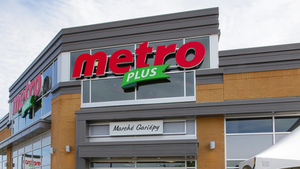WHAT'S UP AT M&S?
Things have taken a strange turn at Marks & Spencer, the venerable international food- and department-store retailer based in London. M&S -- once a beacon to the world of fresh-prepared food and all the logistical backstaging that implies -- has fallen on evil days.Its sales and profits have taken a decided downturn, and, as often the case in such situations, it has been buffeted by numerous executive
January 10, 2000
David Merrefield
Things have taken a strange turn at Marks & Spencer, the venerable international food- and department-store retailer based in London. M&S -- once a beacon to the world of fresh-prepared food and all the logistical backstaging that implies -- has fallen on evil days.
Its sales and profits have taken a decided downturn, and, as often the case in such situations, it has been buffeted by numerous executive reshufflings and now is openly cited as a takeover target. As for its Kings Super Markets subsidiary in New Jersey, M&S said a few weeks ago it's for sale, but no buyer was identified at the time, or since. M&S acquired Kings in 1988. At the time of the buyout, M&S executives told me the idea was to expand the Kings franchise in America and to seek combinations with the parent company that could produce, in 10 years' time, both a larger Kings chain and a M&S chain in America. M&S jumped Kings through many hoops since that time, but it never succeeded in transplanting its methods to these shores, or, for that matter, growing the American food business much.
Many words could be written about M&S' erratic adventure with Kings in America, but maybe more can be apprehended about M&S by looking at its flagship store in London.
As it happens, I was in M&S's Marble Arch flagship on Oxford Street in London a few days ago. Since the store is both a supermarket and a department store, I've made it the object of many visits over the years. The most recent store tour seemed to suggest much about how this high street retailer has changed, and not for the good. Here's a little of what I found:
Inert food: The store's subterranean food floor, of about 8,000 square feet, has changed little over the years. A place that once seemed to all but vibrate with innovation looks dated now. One small, but telling, aspect of design is that after shoppers pay for food, they are obliged to wheel around through a gap in checkout lanes and travel backward through the store -- hands filled with shopping bags -- to reach the escalator. No finer system of shrink encouragement could be devised.
Payment difficulties: M&S doesn't accept credit cards, but for its own, in a manner reminiscent of the pre-regenerated Sears, Roebuck & Co. M&S now deigns to accept a debit card, though. Mine wasn't accepted, although it was issued by one of the world's largest multinational banks. The same bank has a branch on Oxford Street about midway between the M&S store and M&S' world headquarters on Baker Street. The consequence of such transaction difficulties was great mounds of goods jettisoned near department-store paypoints by shoppers without the ability to pay.
More chaos: Granted, this was the post-holiday sale period and M&S offered unprecedented price breaks, but much merchandise in the store was in astonishing disarray. The department store teemed with shoppers who just overwhelmed it. In the shoe department, for instance, display racks were stripped of footwear and the floor was carpeted with mateless shoes strewn helter-skelter.
Based on these observations, at least, M&S seems to have lost its way concerning what its offer to customers is, and has attenuated its once-impressive level of product innovation. That will do it.
About the Author
You May Also Like




